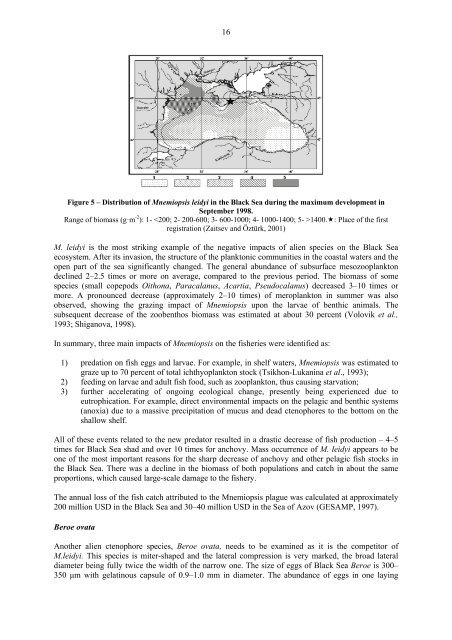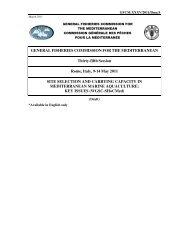Status of alien species in the Mediterranean and Black Sea
Status of alien species in the Mediterranean and Black Sea
Status of alien species in the Mediterranean and Black Sea
Create successful ePaper yourself
Turn your PDF publications into a flip-book with our unique Google optimized e-Paper software.
16<br />
Figure 5 – Distribution <strong>of</strong> Mnemiopsis leidyi <strong>in</strong> <strong>the</strong> <strong>Black</strong> <strong>Sea</strong> dur<strong>in</strong>g <strong>the</strong> maximum development <strong>in</strong><br />
September 1998.<br />
Range <strong>of</strong> biomass (g·m -2 ): 1- 1400.: Place <strong>of</strong> <strong>the</strong> first<br />
registration (Zaitsev <strong>and</strong> Öztürk, 2001)<br />
M. leidyi is <strong>the</strong> most strik<strong>in</strong>g example <strong>of</strong> <strong>the</strong> negative impacts <strong>of</strong> <strong>alien</strong> <strong>species</strong> on <strong>the</strong> <strong>Black</strong> <strong>Sea</strong><br />
ecosystem. After its <strong>in</strong>vasion, <strong>the</strong> structure <strong>of</strong> <strong>the</strong> planktonic communities <strong>in</strong> <strong>the</strong> coastal waters <strong>and</strong> <strong>the</strong><br />
open part <strong>of</strong> <strong>the</strong> sea significantly changed. The general abundance <strong>of</strong> subsurface mesozooplankton<br />
decl<strong>in</strong>ed 2–2.5 times or more on average, compared to <strong>the</strong> previous period. The biomass <strong>of</strong> some<br />
<strong>species</strong> (small copepods Oithona, Paracalanus, Acartia, Pseudocalanus) decreased 3–10 times or<br />
more. A pronounced decrease (approximately 2–10 times) <strong>of</strong> meroplankton <strong>in</strong> summer was also<br />
observed, show<strong>in</strong>g <strong>the</strong> graz<strong>in</strong>g impact <strong>of</strong> Mnemiopsis upon <strong>the</strong> larvae <strong>of</strong> benthic animals. The<br />
subsequent decrease <strong>of</strong> <strong>the</strong> zoobenthos biomass was estimated at about 30 percent (Volovik et al.,<br />
1993; Shiganova, 1998).<br />
In summary, three ma<strong>in</strong> impacts <strong>of</strong> Mnemiopsis on <strong>the</strong> fisheries were identified as:<br />
1) predation on fish eggs <strong>and</strong> larvae. For example, <strong>in</strong> shelf waters, Mnemiopsis was estimated to<br />
graze up to 70 percent <strong>of</strong> total ichthyoplankton stock (Tsikhon-Lukan<strong>in</strong>a et al., 1993);<br />
2) feed<strong>in</strong>g on larvae <strong>and</strong> adult fish food, such as zooplankton, thus caus<strong>in</strong>g starvation;<br />
3) fur<strong>the</strong>r accelerat<strong>in</strong>g <strong>of</strong> ongo<strong>in</strong>g ecological change, presently be<strong>in</strong>g experienced due to<br />
eutrophication. For example, direct environmental impacts on <strong>the</strong> pelagic <strong>and</strong> benthic systems<br />
(anoxia) due to a massive precipitation <strong>of</strong> mucus <strong>and</strong> dead ctenophores to <strong>the</strong> bottom on <strong>the</strong><br />
shallow shelf.<br />
All <strong>of</strong> <strong>the</strong>se events related to <strong>the</strong> new predator resulted <strong>in</strong> a drastic decrease <strong>of</strong> fish production – 4–5<br />
times for <strong>Black</strong> <strong>Sea</strong> shad <strong>and</strong> over 10 times for anchovy. Mass occurrence <strong>of</strong> M. leidyi appears to be<br />
one <strong>of</strong> <strong>the</strong> most important reasons for <strong>the</strong> sharp decrease <strong>of</strong> anchovy <strong>and</strong> o<strong>the</strong>r pelagic fish stocks <strong>in</strong><br />
<strong>the</strong> <strong>Black</strong> <strong>Sea</strong>. There was a decl<strong>in</strong>e <strong>in</strong> <strong>the</strong> biomass <strong>of</strong> both populations <strong>and</strong> catch <strong>in</strong> about <strong>the</strong> same<br />
proportions, which caused large-scale damage to <strong>the</strong> fishery.<br />
The annual loss <strong>of</strong> <strong>the</strong> fish catch attributed to <strong>the</strong> Mnemiopsis plague was calculated at approximately<br />
200 million USD <strong>in</strong> <strong>the</strong> <strong>Black</strong> <strong>Sea</strong> <strong>and</strong> 30–40 million USD <strong>in</strong> <strong>the</strong> <strong>Sea</strong> <strong>of</strong> Azov (GESAMP, 1997).<br />
Beroe ovata<br />
Ano<strong>the</strong>r <strong>alien</strong> ctenophore <strong>species</strong>, Beroe ovata, needs to be exam<strong>in</strong>ed as it is <strong>the</strong> competitor <strong>of</strong><br />
M.leidyi. This <strong>species</strong> is miter-shaped <strong>and</strong> <strong>the</strong> lateral compression is very marked, <strong>the</strong> broad lateral<br />
diameter be<strong>in</strong>g fully twice <strong>the</strong> width <strong>of</strong> <strong>the</strong> narrow one. The size <strong>of</strong> eggs <strong>of</strong> <strong>Black</strong> <strong>Sea</strong> Beroe is 300–<br />
350 μm with gelat<strong>in</strong>ous capsule <strong>of</strong> 0.9–1.0 mm <strong>in</strong> diameter. The abundance <strong>of</strong> eggs <strong>in</strong> one lay<strong>in</strong>g
















